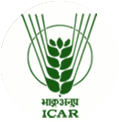 |
भा.कृ.अ.प. - भारतीय कृषि अनुसंधान संस्थान | ICAR-Indian Agricultural Research Institute |
 |
Nematology (12 scientists)

M.Sc. : G. B. Pant University of Agriculture and Technology, Pantnagar, Uttarakhand, India
Ph.D : ICAR- Indian Agricultural Research Institute, New Delhi, India
Google Scholar
PG School, Faculty Disciplines : Nematology
No. of Students Guided : - M.Sc : 3
Publications having NAAS rating 6 and above with first or corresponding author only
- Somvanshi, V. S., Sloup, R. E., Crawford, J. M., Martin, A. R., Heidt, A. J., Kim, K. S., ... & Ciche, T. A. (2012). A single promoter inversion switches Photorhabdus between pathogenic and mutualistic states. Science, 337(6090), 88-93.
- Somvanshi, V. S., Lang, E., Str�ubler, B., Spr�er, C., Schumann, P., Ganguly, S., ... & Stackebrandt, E. (2006). Providencia vermicola sp. nov., isolated from infective juveniles of the entomopathogenic nematode Steinernema thermophilum. International Journal of Systematic and Evolutionary Microbiology, 56(3), 629-633.
- Somvanshi, V. S., Kaufmann‐Daszczuk, B., Kim, K. S., Mallon, S., & Ciche, T. A. (2010). Photorhabdus phase variants express a novel fimbrial locus, mad, essential for symbiosis. Molecular microbiology, 77(4), 1021-1038.
- Somvanshi, V. S., Lang, E., Ganguly, S., Swiderski, J., Saxena, A. K., & Stackebrandt, E. (2006). A novel species of Xenorhabdus, family Enterobacteriaceae: Xenorhabdus indica sp. nov., symbiotically associated with entomopathogenic nematode Steinernema thermophilum Ganguly and Singh, 2000. Systematic and applied microbiology, 29(7), 519-525.
- Somvanshi, V. S., Ellis, B. L., Hu, Y., & Aroian, R. V. (2014). Nitazoxanide: nematicidal mode of action and drug combination studies. Molecular and biochemical parasitology, 193(1), 1-8.
- Somvanshi, V. S., Ganguly, S., & Paul, A. V. N. (2006). Field efficacy of the entomopathogenic nematode Steinernema thermophilum Ganguly and Singh (Rhabditida: Steinernematidae) against diamondback moth (Plutella xylostella L.) infesting cabbage. Biological Control, 37(1), 9-15.
- Somvanshi, V. S., Koltai, H., & Glazer, I. (2008). Expression of different desiccation-tolerance related genes in various species of entomopathogenic nematodes. Molecular and biochemical parasitology, 158(1), 65-71.
- Somvanshi, V. S., Tathode, M., Shukla, R. N., & Rao, U. (2018). Nematode genome announcement: A draft genome for rice root-knot nematode, Meloidogyne graminicola. Society of Nematologists (via Exeley Incorporated).
- Somvanshi, V. S., Gahoi, S., Banakar, P., Thakur, P. K., Kumar, M., Sajnani, M., ... & Rao, U. (2016). A transcriptomic insight into the infective juvenile stage of the insect parasitic nematode, Heterorhabditis indica. BMC genomics, 17(1), 166.
- Bhat, C. G., Chauhan, K., Phani, V., Papolu, P. K., Rao, U., & Somvanshi, V. S. (2019). Expression of Heterorhabditis bacteriophora C-type lectins, Hb-clec-1 and Hb-clec-78, in context of symbiosis with Photorhabdus bacteria. Symbiosis, 77(1), 49-58.